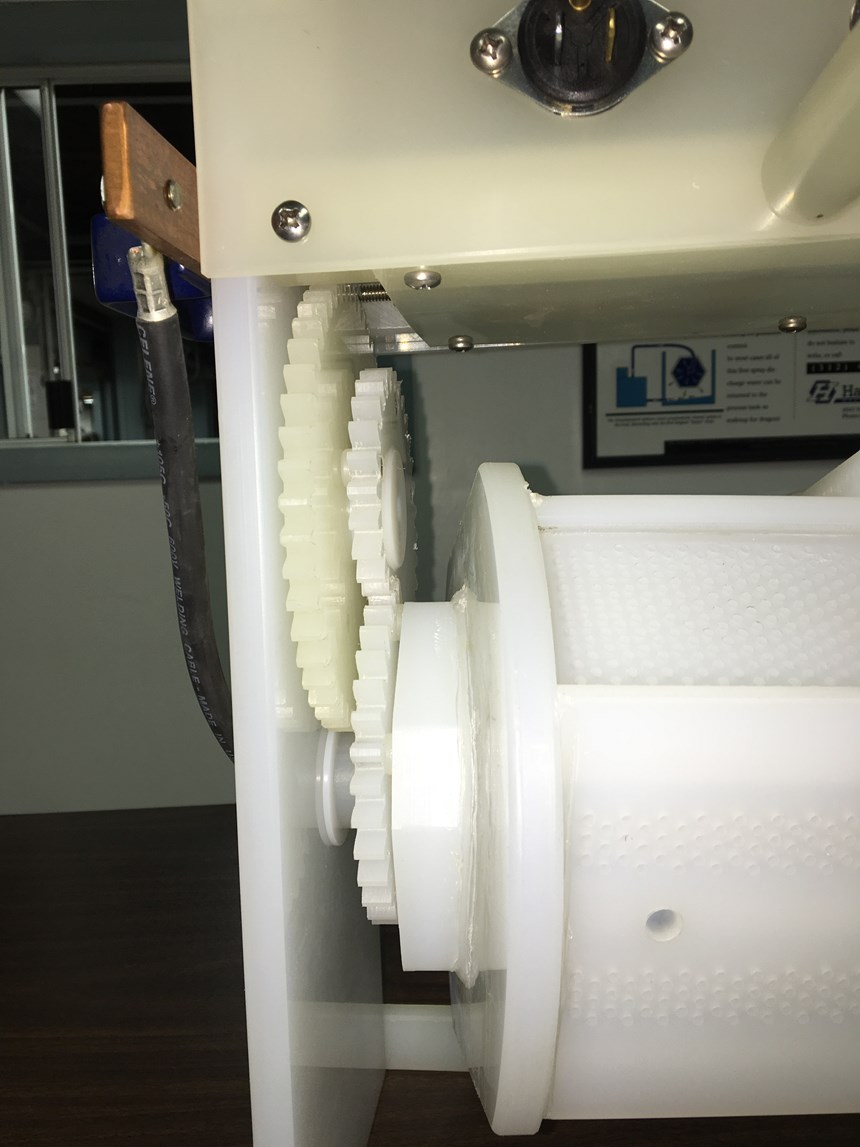Hardwood Line Changes Paradigm for Plating Small Parts
Its prototype is a lithium ion battery-powered barrel with special gearing.
For over 85 years, Hardwood Line Manufacturing in Chicago, Illinois, has been constantly looking for better ways for metal finishers to reduce rejects and improve margins.
Recently, a barrel customer was experiencing a lot of rejects in their plating process for battery caps and asked Hardwood for help. The reject rate using traditional barrels was well over 40%. “Visually sorting the rejects is next to impossible when there are as many bad as good parts,” says Tony Lazaro, Hardwood Line president. “And we’re talking about millions of small, very thin caps.”
The philosophy of barrel plating is simple—keep tumbling parts until all of them meet specification and are completely plated. That process, however, is difficult with thin washers or battery caps because those parts tend to stick together. “Platers have problems breaking apart flat, thin parts. Because of their shape and the constant revolution at the same RPM, those parts seem to align and form chains,” Lazaro says. “When that happens, you just don’t get good plating because you need to expose all the surfaces of the part.”
High rejection rates result in a time-consuming sorting process—all at a high cost and low margin. What can platers do? According to Lazaro, many companies that plate thin washers or caps usually minimize load size, increase cylinder speed or add filler in order to try get the load to break apart, but the outcome is usually the same.
“It was only through trial-and-error that we stumbled upon an answer to part separation,” Lazaro says with each change resulting in only incremental improvement. It was only when they put all the changes together that they were able to fully eliminate rejects.
The first step was the addition of breaker bars to the existing cylinder. Breaker bars, by design, lift and drop parts, but that didn’t do much.
The next change was to replace the cylinder with an oscillating plating barrel which, by design, forces parts to move in a figure eight path. That dropped the reject rate slightly, but it still wasn’t good enough.
For the third—and perhaps most critical change—Hardwood Lines head engineer Frank Pusateri came up with an idea to mechanically force the cylinder to jump during each rotation. This was accomplished by replacing the traditional idler gear with compound or Nautilus gearing so that each revolution would include a snap that would create enough turbulence to kick the parts away from each other. “It’s the kick that differentiates it from a traditional, constant-speed cylinder,” Lazaro says, “and it was the kick that broke them apart.”
The compound gear greatly improved the process, but the customer still wasn’t happy. They asked for one last tweak. Could Hardwood speed up the barrel rotation? Hardwood responded by doubling the motor speed and the result was zero rejects. “The trial-and-error approach works, especially when you stick with it and have a customer willing to put in the time and effort,” Lazaro says.
Related Content
-
How to Maximize Nickel Plating Performance
The advantages of boric acid-free nickel plating include allowing manufacturers who utilize nickel plating to keep up the ever-changing regulatory policies and support sustainability efforts.
-
3 Tests to Ensure Parts are Clean Prior to Plating
Making sure that all of the pre-processing fluids are removed prior to plating is not as simple as it seems. Rich Held of Haviland Products outlines three tests that can help verify that your parts are clean.
-
Products Finishing Reveals 2024 Qualifying Top Shops
PF reveals the qualifying shops in its annual Top Shops Benchmarking Survey — a program designed to offer shops insights into their overall performance in the industry.

















.jpg;maxWidth=300;quality=90)
